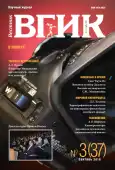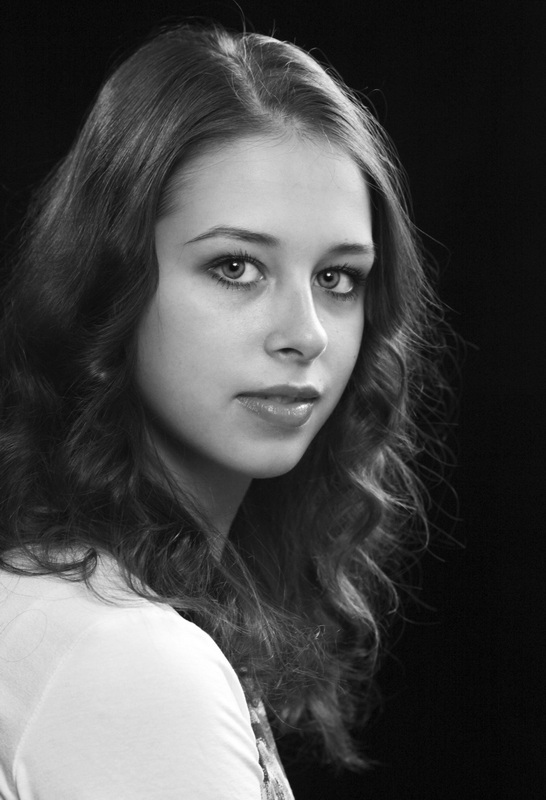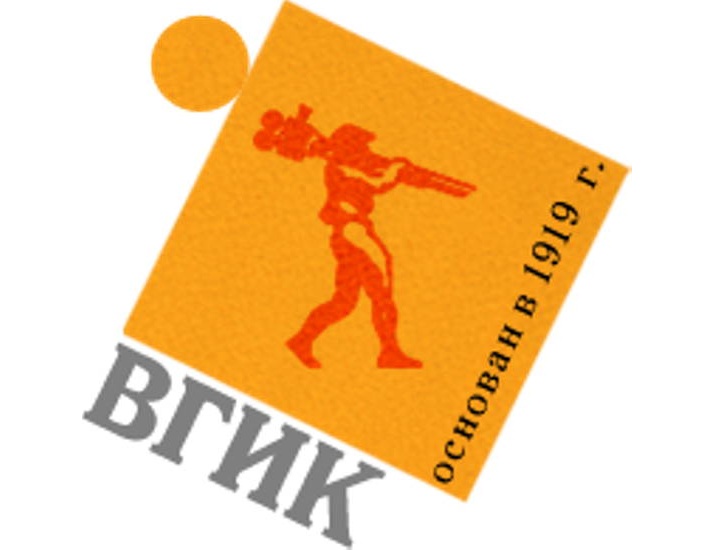Vol 10, No 3 (2018)
- Year: 2018
- Articles: 18
- URL: https://journals.eco-vector.com/2074-0832/issue/view/869
- DOI: https://doi.org/10.17816/VGIK103
CHRONICLE IN DETAIL | CURRENT EVENTS
VGIK. Raznoobrazie graney mezhdunarodnogo sotrudnichestva
Abstract
In a series of events in the creative life of VGIK it is worth highlighting two – the 10th International summer film school of VGIK in Krasnodar, dedicated to the 100th anniversary of the University, and-screenings of Iranian films in the framework of "Days of culture of Iran in Russia" in the walls of VGIK. These events reveal the facets of international cooperation of the University, testify to its organizational and creative potential, limitless humanistic possibilities inherent in the film and screen arts.
 6-6
6-6


THEORY AND HISTORY OF CINEMA | AUDIOVISUAL ARTS
Vladimir Mayakovsky as a Film Actor: a “Star” or an Amateur?
Abstract
The article considers the activity of V.V. Mayakovsky as a film actor. In 1918 he starred in three films: Not for Money Born, The Young Lady and the Hooligan, and Shackled by the Film, of which only one survived — The Young Lady and the Hooligan. This film was a success, and the reviewer of the magazine “Rampa and life” highlighted exactly Mayakovsky, who “has made a very good impression and promises to be a very good typical actor”.
Basing on the analysis of the film The Young Lady and the Hooligan and the testimonies of contemporaries, it is possible to identify the characteristic features of Mayakovsky's acting. He was “a good object for cinema”, “cinematic sitter”: “a man with a characteristic appearance, with a certain, pronounced character”. Mayakovsky's ability to “save movements” and “not to invent deliberate gestures”, bypassing the usual, machine, on the one hand, seemed to contradict the general aesthetics of silent cinema, coming from the expressiveness of gesture and facial expressions, but, on the other, it fits well into the tradition of pre-revolutionary “Russian style”, characterized by “minimalist technique of playing of a Russian actor”.
Thus Mayakovsky tries to bring in it more dynamics — so, from the first shots in hands of the hero there is a cavalry whip with which he manipulates, gestures expressing an emotional state of the hero: twirls fingers (carelessness), knocks down a grass and branches (excitement or anger), breaks off a fraction (impatience). A separate attention deserves glance-as a special gesture, extremely important for dumb cinedrama. In The Young Lady and the Hooligan the Mayakovsky’s character often rather watches than performs something. But the most expressive is a direct look into the camera, and there are only two such gesture- images: the first in the scene of love confession in the classroom; the second — in the scene of the death of the hero.
Thus Vladimir Mayakovsky could not become a professional film actor because of his organic impossibility to reincarnate, but his acting was not accidental — because the desire to manifest himself to the world was part of his nature as an artist, and he could and played his own way. Today this type of behavior could be associated with that of a “media person”, like the writer Zakhar Prilepin, who also sometimes appears in films.
 7-18
7-18


Sound as a Sign and Artistic Symbol in Film
Abstract
In the article the semantic and symbolic aspects of sound are analyzed in the context of the actual problem of creation of screen audio-visual image. These aspects of cinematic sound have not received sufficient attention in film theory yet, since they are related to the need to move from the field of cinema to the sphere of philosophical and aesthetic problems. The theme of sound semiotics and symbolism in the film also implies an appeal to the history and content of the very concepts of the sign and symbol, as well as to the features of the director's worldview and artistic language. The problem of sound values and meanings becomes more complicated if we consider sound not only within the framework of author's (director's) aesthetics, but also in terms of its perception and understanding by the viewer. Interpreting sound as a sign or symbol in the film can be done at various levels of theorizing, in different historical and cultural contexts. The article proposes the systematization of the semantic values of film sound, taking into account the historical and aesthetic stages of the development of cinema: sound as a sign-indicator of the epoch, sound as the exponent of existential meanings, musical sound as an artistic symbol. The possibility of forming multi-level polysemantic sound structures in a motion picture is emphasized, which can be facilitated by modern technical and technological capabilities of sound engineering. It is concluded that the need to refer to the sound symbol should flow not only and not so much from the plot material or technical possibilities of sound recording as from the author's internal need for its use, from the principles of aesthetics, cultural experience and the worldview of the director.
 19-33
19-33


The Way of Genre in Cinema Documentary
Abstract
The aim of the article is to examine the peculiarities of the genre structure of cinema documentaries, its conceptual vocabulary, the factors that form the key genres in documentary, their historical dynamics and contemporary problems. At the same time, the root issues of the artistic structure of the screen document are analyzed, as well as the dialectic of the requirements for the authenticity and expressiveness of works of this kind of cinema, the specificity of the documentary image that determines the multiformity of the genre system of documentaries.
The category “genre”, which determines the structure and system of the expressive means of a piece of art, accompanies the history of arts for many centuries. Screen arts have developed their genre forms, coupled with an independent system of artistic expressiveness. Cinema documentary has its own genre structure, but till nowadays there have been delivered debates about the factors that influence the genre structure of this type of cinema. The author of the article offers his view on the existence of the genre in the artistic system of screen documentary, not supporting popular attempts to compose certain catalogues of genres. Actual practice breaks such speculative “catalogues”. It is more productive to view the field of documentaries as broad directions: informational, live recording, essay, feature documentary, inside of which individual genre forms of movies are born, following the core laws of relations of the author and material inherent in this direction. The article points to the historical mobility of the content of accepted concepts in the theory of cinema documentary, as well as to the specifics of the structure of the documentary image and the discussion of externally axiomatic provisions of the aesthetics of documentary, such as “reliability”, “screen document”, “film chronicle”. The text also touches upon the actual issues of artistic expressiveness of contemporary Russian documentaries.
 34-44
34-44


FILM LANGUAGE AND TIME | IMAGE GENESIS
The Influence of Far Eastern Culture on the Creative Work of S.M.Eisenstein
Abstract
The concept of montage, created by S.M.Eisenstein, is one of the most epochal and polemic in the whole history of film art. One of the methods which worked as a good catalyst for the development of Eisenstein’s film language is Far Eastern culture and Japanese art in particular.
The influx of Japanese culture upon Russia started from the popularity of Japanese color print in Europe and political trends after Russian-Japanese War. Eisenstein, rooted in both European cultural background and political stance, was impressed by his mentor V.E.Meyerhold’s acceptance of Japanese culture.
Among the oriental references studied by Eisenstein and applied to the theory and cinema, there were many Japanese aesthetic and philosophic ideas and trends such as the process of forming hieroglyphics, the images of Haikai and Tanga, Kabuki theatre and Japanese portrait. According to Eisenstein, these are all similar to what cinema does. In other words, two pieces collide to create a new meaning through dialectical process.
His concept of montage, which was actively studied with the help of oriental culture as a catalyst, is still topical. And it helps greatly to create a new film language. Although it is often used in mainstream cinema, such as Holwood blockbusters, the aesthetic meaning of film art has been evolving on the basis of montage..
 45-54
45-54


Mythologeme of Asceticism in the National Cinema the 1930s
Abstract
The article is devoted to the mythologeme of asceticism, widespread in the domestic cinema of the 1930s and closely connected with the mythmaking of the Soviet system, the ideology of which was largely based on the moral principles of Christianity. Acting as the “apparatus of agitation”, the cinema of the “big style” created a new mythology, its cultural hero was an ascetic who orders chaos and ready for self-sacrifice for the sake of the common good.
A distinctive feature of the “big style” was the so-called mythological triad: the party (invisibly present behind the scenes) — the mentor and the pupil (the teacher Sergeyev – the homeless Mustafa in the Road to Life, the secretary of the district committee — Sasha Sokolova in the Member of the Government, etc.).
The pupil — in the past standing at the lowest level of the social hierarchy finds its “light way” by successfully realizing the main socialist message “who was nothing will become everything”.
Ascetic is an innovator and an envoy of Soviet power, a mediator between her and the people, dictating to society a new moral code (Teacher, Member of the Government).
Mass promotion of women as one of the most oppressed members of society to key positions occurred in the 1930s. At this time, the Cinderella archetype literally blossoms: the fate of a woman from the people becomes a living embodiment of the idea of a society of equal opportunities (Member of the Government, The Light Road, Volga-Volga, Jolly Fellows).
While the official equality of citizens is declared at the state level, true equality and spiritual kinship of souls are achieved only through personal achievements for the benefit of the country.
For a happy family life and successful self-fulfillment in the work collective, asceticism was an indispensable condition and a natural form of existence, prescribed “from above” by the norm of life.
Thus, the idea of asceticism as the main principle of Christianity will become the basis of a new mythology, proposed by the Soviet power instead of the forbidden religion.
 55-65
55-65


READING-ROOM | BOOK SHELF
 66-66
66-66


PERFORMANCE | ART OF PRESENTATION
Characteristics of Traditional Aesthetics in the Film Music of the Far East Countries
Abstract
The article is devoted to the problem of film music in the cinema of the Far East countries. This topic has been insufficiently investigated in the Russian film studies and musicology. Summarizing the experience of Russian researchers of audiovisual synthesis in the film, the author of this article tries to extrapolate it to the Far Eastern material. So, on the basis of the film audiovisual design theory, it is proposed that the main factor influencing the audiovisual synthesis in the film is to highlight the aesthetic space in which the authordirector exists and creates and the characteristics of his attitude to this space.
Therefore, the focus of attention is the question of the influence of traditional aesthetics on audiovisual synthesis in the films of the Far East directors. It is noted that there was formed a highly developed, original philosophical and aesthetic tradition (conjugated with Buddhism and Taoism) in China. This tradition had an impact on all Far Eastern art in general, which in turn affected the Far East cinema. This is characteristic of the synthetics of the Far Eastern art culture in general.
Basing on the understanding that the mythological and symbolic origins of all visual arts, theater, music and cinema are connected with traditional aesthetics, the author considers the basic aesthetic principles, including the ideas of “hidden beauty”, “artless simplicity”, “religious reminiscences”, etc. on the example of some films. In a detailed analysis of the short film 100 Flowers Hidden Deep (dir. Chen Kaige), symbolic relationships between visual and sound images of Chinese traditional culture are revealed, through which the deep meaning of the film is conveyed.
The author of the article comes to the conclusion that considering the films of the Far East directors it is possible to trace down several semantic levels, visible and hidden, which give multidimensionality to the film text, where each dimension flows into the other. Thus, the audiovisual design of the film harmoniously inscribes into the context of Chinese traditional aesthetics with its symbolic system, without knowledge of which it is impossible to understand the author's intention.
 67-77
67-77


Stunt Trickery as an Effective Spectacle Means of Artistic Expressiveness
Abstract
The emergence of the concept of film stunt is inextricably connected with the period of dramatic artistic and practical transformations in stunt performance. The experimental basis which served as a perfect platform for realizing the boldest ideas in stunt presentation formed an invaluable material of one of the most spectacular and impressive forms of film expressiveness. Film stunt was to work its own way of establishment, development and perfection. At first, it was brought to life by situational necessity.
Filmmakers used various methods of making first stunts based on freezeframes, stop motion, double (and multiple) exposure, fast (and slow) motion, matting and other techniques which were creative innovations at the time promising a huge success to action movies that conquered the screen. Stunt performance was just the most eye-catching part of “Eisenstein’s attractions”, providing additional expressive means of film language. The stunt was not a fullfledged part of the character’s plastic pattern (it did not belong to the performer, neither was it identified with the character executing it). It was only later that the stunt began to be personified in the artistic context of an individual character’s plastic pattern as well as in the genre structure of the narrative. The stunt became part of the film’s plot-line. Its organic incorporation into the accurately built and logically balanced structure of the audiovisual production gave it a new emotional palette. Some time later, the stunt turned into an integral part of a film phrase, getting the status of plastic (and action) metaphor with a different meaning. It has become ingrained in the cinematic life of all continents taking a rightful place the international film vocabulary.
 78-85
78-85


The Doppelgänger Motif in the “New Sincerity” Cinema
Abstract
The author assumes, that doppelgänger motif is repeatedly presented in the “new sincerity” films. In these films, the doppelgänger motif reflects the drama of the split personality or the notion of identity. The doppelgänger represents an embodiment of the unconscious, and it is also a variation of the Shadow Archetype from Jungian psychology. In «new sincerity» aesthetics the unconscious contains roots of sincerity.
The doppelgänger expresses the protagonist’s willing to determine the identity. The protagonist denies accepting one’s own nature and thus this part of the divided consciousness becomes his doppelgänger. The doppelgänger motif is used to emphasize the protagonist’s inability to be sincere with oneself and one’s infantilism. The characters are constantly fighting between the contemplation of the hidden features of their own personality and their inert existence. The “new sincerity” cinema is characterized by oscillation between irony of postmodernist art and sincerity.
In the subject matter the doppelgänger motif appears when the protagonist is looking for one’s own reflection and faces a faked doppelgänger but then finally meets the true doppelgänger. This encounter happens due to the external obstacles. Visually the doppelgänger motif is shown when the protagonist talks to one’s reflection in the mirror or to the audience while looking straight into the camera, on the stage of a circus, in a dream. These spaces symbolize the sphere of the unconscious.
The academic novelty of this article consists in consideration of almost unexplored art language in Russian cinema which contains the renovation of the cinema language and considers the conflicts of nowadays.
 86-96
86-96


WORLD CINEMA | ANALYSIS
The Image of Femme Fatale in German Films of the 1920s as Evidence of the Process of Society Renewal
Abstract
Novel representations of female characters have always certified highly significant historical changes. These images tend to become crucial for understanding a certain epoch. In the German cinema of the 1920s one of such images signifying the essence of the epoch and many of its historic problems is the character of Femme fatale, which substitutes the images of the 19th century romantic woman craving for male defense and support and stimulating male creativity with her fragility and “sterile” beauty. Cinema was able to represent the concept of “the new woman” which was evolving in Western society at the end of the 19th century and at the dawn of the 20th century and signified a cardinal change in her socio-cultural status. A large number of films incorporates the image of Femme fatale — frequently a prostitute contrasting her immoral behavior with the mothers and wives of the patriarchal society and, therefore, challenging the traditional morals, putting it in jeopardy of destruction, which means inevitable renewal.
The essay’s author analyses the most representative films of this tendency: Genuine: A Tale of a Vampire; Tragedy of the Street, and Asphalt. Analysis of the claimed pictures allows to see the changes taking place in the representation of this image: as from the semi-mythical demonic creature (vampire), the heroine is transformed into a real woman with a clear vital position. As the myth of the "new woman" in the German cinema of the 1920s, revealing the situation of the gender crisis of the early 20th century, it acquires a program character, where the idea of the renewal of society and the harmonization of the world is behind the concept of gender equality.
 97-106
97-106


Choreographic Art on the Cinema Screen: Film-Ballet or Ballet-Film?
Abstract
Ballet first appeared in cinema in 1908, and on TV — in the 1940s. By the early 1990s about 300 filmed ballets and concerts had been collected in the film library. Nowadays the world broadcasting of ballet performances become the most demanded.
The one that stands out is The Lady of the camellias staged by John Neumeier. This choreographer is an outstanding figure of contemporary ballet theatre. His The Lady of the camellias appeared on stage in 1978, and then in 1986 a film under the same name was processed. Neumeier directed the video and did the filming himself. In this regard the main part of the article is devoted to comparative analysis of arbor imagery in both stagings.
The novelty of present article is in highlighting the features of cinema and ballet, which are combined by Neumeier in one production. At the same time the choreographer emphasizes the uniqueness of both choreographic and cinematic arts. The author concludes that John Neumeier was able to combine two different fields and create something new at their intersection.
 107-115
107-115


ЧИТАЛЬНЫЙ ЗАЛ | КНИЖНАЯ ПОЛКА
 116-116
116-116


TELEVISION | DIGITAL ENVIRONMENT
Small Screen and Great Ambitions: Australian Television Series in the Cultural Context of the Country
Abstract
Television series occupy a significant place in the Australian television network and in the culture of the country as a whole. Their role in forming the taste and needs of society is huge.
These works of different genres, addressed to almost all segments of the population, have a tremendous impact on the consciousness, and sometimes subconsciousness of the audience.
The TV-series of the Green continent is not a narrow national phenomenon, Australia actively cooperates in the production of movies for TV with other countries, almost all the series are coproduction, which give Australia both investments for production and the possibility of transmitting in all regions of the world. Australian series are popular in Russia. We must also admit that the TV-series are a sphere for experiments of the leading directors, who at this time do not have projects in the big movie, and the launch pad for debutants, who have become popular on television then most often go into the feature films (indicative example of creativity is P. Weir — the author of Picnic at Hanging rock, Dead Poets Society, The Truman Show, etc.). Finally, for the actors of the country — this is a real chance to declare themselves to producers and viewers, to gain fame.
Australian soap operas are really popular and successful all over the world.
 117-127
117-127


Film Viewing of the Russians on TV Channels: Sociological Analysis
Abstract
In the context of increasing digitalization of media-space, the analysis of broadcasting films on Russian leading TV channels is of intense interest. The article examines the specific character of movie broadcasting in general and the films preferred by Russian TV audience. The analysis is based on the viewing grids of 22 Russian channels in the July of 2018 taking into account the main data of film repertoire on TV and the preferences of the audience in accordance with the age categories.
 128-143
128-143


Multivariance of Reality in the Digital Paradigm
Abstract
The article validates the terms based on the notion of ‘reality’ that have started to be used in the media due to the implementation of digital technologies. Emphasis is laid on Virtual Reality (VR) and its types: Augmented Reality (AG) and Mixed Reality (MR). Дєіг application updates the approaches to the creation of film and TV productions, alters the immanent bond with the audience. tte terms are correlated with the concepts of ‘media reality’ and ‘screen reality’ introduced into scientific use. As a result, there emerges a multireality which affects the individual’s perception.
 144-151
144-151


SUMMARY | PRESENTATION OF AUTHORS
 152-157
152-157


RECOMMENDATIONS AUTHORS
REKOMENDATsII AVTORAM
Abstract
The academic journal Vestnik VGIK is the leading periodical publication of the All-Russian State Institute of Cinematography named after S.A.Gerasimov, who is the founder of the publication.
Recommendations to authors interested in publishing articles.
 158-160
158-160



























